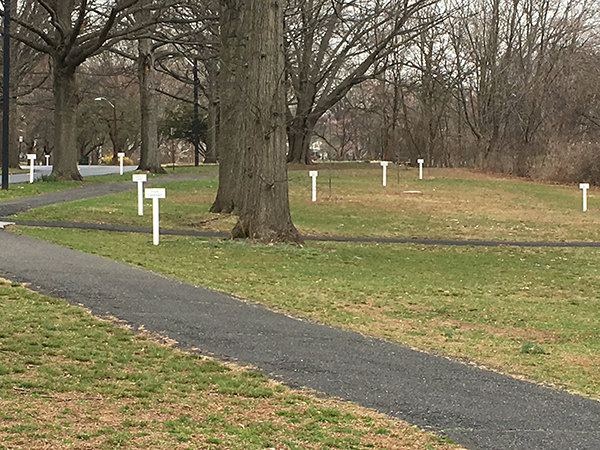
(above) Name markers stand next to Memorial Trees in tribute to Rahway’s fallen soldiers.
Names Posted and New Trees Planted at Rahway County Park Memorial Grove
The trees that were planted at Rahway County Park seventy-two years ago as a symbolic gesture to memorialize the fifty-eight Rahway servicemen who died during World War II are no longer forgotten. This past December, name markers were placed next to the original trees representing each fallen soldier and also placed next to saplings which were planted last spring to replace the trees that were lost to disease, storm damage, or removal. The commemorative stone that was laid during the 1947 ceremony has been refurbished and placed in a more prominent setting. With much of the revitalization work complete, a brief program, conducted by the Union County Department of Veterans’ Affairs, was held on Thursday, December 20, 2018 to rededicate the grove.
At the conclusion of World War II, the Rahway American War Dads, Chapter 6, initiated a project to create some method of honoring the local servicemen who died during the war. Their project evolved into the creation of a Memorial Tree Grove that would surround a monument to be placed in the Rahway County Park.
The dedication service, which took place on Memorial Day, 1947, was impressive. The observance began with a long parade that started in the business district and ended in the park where several thousand people, young and old, had gathered. A bronze plaque, set on a large boulder, was unveiled which listed the names of the fifty-eight servicemen. The dedication continued with the reading of the names of the soldiers. A Boy Scout stood next to each tree and saluted as the designated name was announced. Following the roll call, speeches were given by local, county, and state officials. After a gun salute was fired by an honor guard from Camp Kilmer, the ceremony closed with an Army bugler playing “Taps.” It was later reported that the Memorial Tree Grove was the first and most suitable method to honor the war heroes.
In the years following the dedication service and tree plantings, the ceremonial program faded with the passage of time, and before long, the tribute to Rahway’s war dead was all but forgotten. Few if any would take notice of the boulder that had become surrounded by hedge growth or the trees which as years passed bore no more significance than any others that filled the park’s acreage. All this would change, however, in January, 2015, when a map was discovered which showed the position of each tree and included a key that matched trees with soldiers.
With the newly found map, the Memorial Trees that were still standing were located through the efforts of the staff of the Merchants and Drovers Tavern Museum Association and an observance was held on May 12, 2015 to renew interest in the grove. Members of the Merchants and Drovers, Rahway Post 5 American Legion, the Rahway High School ROTC, and representatives from the Union County Parks Commission gathered in the park to place American flags next to each tree.
More work, however, needed to be done. First, trees had to be planted to replace those that had not survived. Secondly, identification markers were needed to draw attention to the trees so their significance might be more readily noted. Divisions of the Union County Parks Commission and the Veterans’ Affairs Department took on the project. During the county’s next cycle of tree plantings, saplings were planted and name markers were put in place for most of the soldiers (about a dozen names still need to be posted and some markers need to be repositioned).
The Rahway News-Record editorial from June 5, 1947 commented, the grove will be “a memorial which will grow as the years pass to keep generations aware of the sacrifice which these men made to permit the continuation of our way of life.” When finally completed, the Memorial Grove will again be a suitable memorial that will continue to honor Rahway’s World War II heroes for a new generation.
Submitted by Al Shipley, City Historian and Rahway Library Research Consultant
